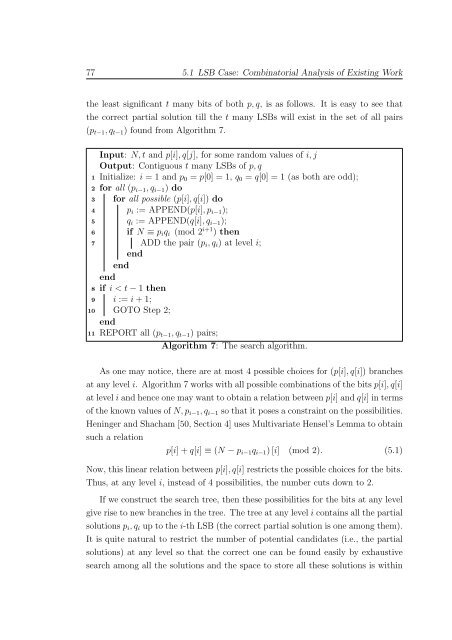Cryptanalysis of RSA Factorization - Library(ISI Kolkata) - Indian ...
Cryptanalysis of RSA Factorization - Library(ISI Kolkata) - Indian ...
Cryptanalysis of RSA Factorization - Library(ISI Kolkata) - Indian ...
You also want an ePaper? Increase the reach of your titles
YUMPU automatically turns print PDFs into web optimized ePapers that Google loves.
77 5.1 LSB Case: Combinatorial Analysis <strong>of</strong> Existing Work<br />
the least significant t many bits <strong>of</strong> both p,q, is as follows. It is easy to see that<br />
the correct partial solution till the t many LSBs will exist in the set <strong>of</strong> all pairs<br />
(p t−1 ,q t−1 ) found from Algorithm 7.<br />
1<br />
2<br />
3<br />
4<br />
5<br />
6<br />
7<br />
8<br />
9<br />
10<br />
11<br />
Input: N,t and p[i],q[j], for some random values <strong>of</strong> i,j<br />
Output: Contiguous t many LSBs <strong>of</strong> p,q<br />
Initialize: i = 1 and p 0 = p[0] = 1, q 0 = q[0] = 1 (as both are odd);<br />
for all (p i−1 ,q i−1 ) do<br />
for all possible (p[i],q[i]) do<br />
p i := APPEND(p[i],p i−1 );<br />
q i := APPEND(q[i],q i−1 );<br />
if N ≡ p i q i (mod 2 i+1 ) then<br />
ADD the pair (p i ,q i ) at level i;<br />
end<br />
end<br />
end<br />
if i < t−1 then<br />
i := i+1;<br />
GOTO Step 2;<br />
end<br />
REPORT all (p t−1 ,q t−1 ) pairs;<br />
Algorithm 7: The search algorithm.<br />
As one may notice, there are at most 4 possible choices for (p[i],q[i]) branches<br />
at any level i. Algorithm 7 works with all possible combinations <strong>of</strong> the bits p[i],q[i]<br />
atleveliandhenceonemaywanttoobtainarelationbetweenp[i]andq[i]interms<br />
<strong>of</strong> the known values <strong>of</strong> N,p i−1 ,q i−1 so that it poses a constraint on the possibilities.<br />
Heninger and Shacham [50, Section 4] uses Multivariate Hensel’s Lemma to obtain<br />
such a relation<br />
p[i]+q[i] ≡ (N −p i−1 q i−1 )[i] (mod 2). (5.1)<br />
Now, this linear relation between p[i],q[i] restricts the possible choices for the bits.<br />
Thus, at any level i, instead <strong>of</strong> 4 possibilities, the number cuts down to 2.<br />
If we construct the search tree, then these possibilities for the bits at any level<br />
give rise to new branches in the tree. The tree at any level i contains all the partial<br />
solutions p i ,q i up to the i-th LSB (the correct partial solution is one among them).<br />
It is quite natural to restrict the number <strong>of</strong> potential candidates (i.e., the partial<br />
solutions) at any level so that the correct one can be found easily by exhaustive<br />
search among all the solutions and the space to store all these solutions is within
















